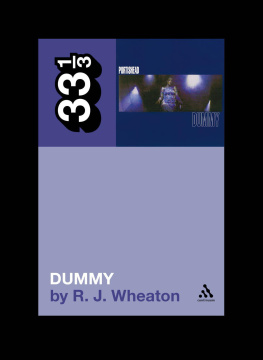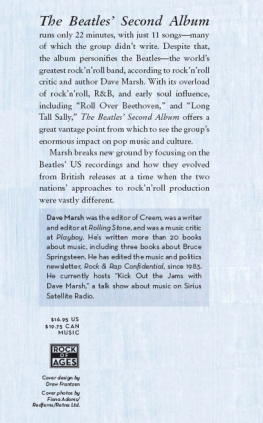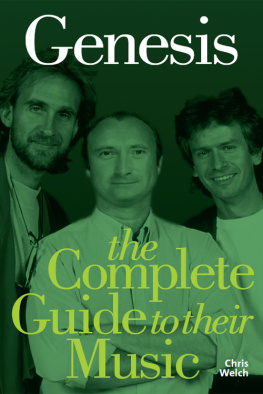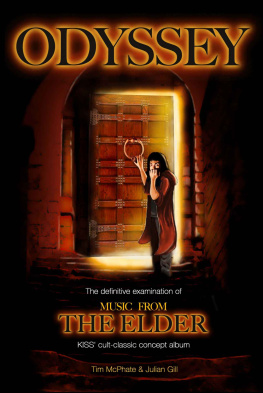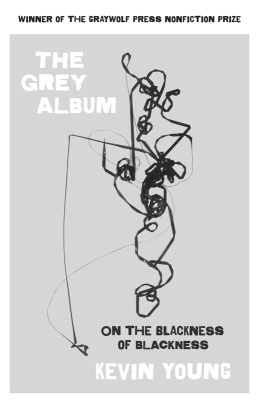

DUMMY
Praise for the series:
It was only a matter of time before a clever publisher realized that there is an audience for whom Exile on Main Street or Electric Ladyland are as significant and worthy of study as The Catcher in the Rye or Middlemarch The series is freewheeling and eclectic, ranging from minute rock-geek analysis to idiosyncratic personal celebration The New York Times Book Review
Ideal for the rock geek who thinks liner notes just arent enough Rolling Stone
One of the coolest publishing imprints on the planet Bookslut
These are for the insane collectors out there who appreciate fantastic design, well-executed thinking, and things that make your house look cool. Each volume in this series takes a seminal album and breaks it down in startling minutiae. We love these. We are huge nerds Vice
A brilliant series each one a work of real love NME (UK)
Passionate, obsessive, and smart Nylon
Religious tracts for the rock n roll faithful Boldtype
[A] consistently excellent series Uncut (UK)
We arent naive enough to think that were your only source for reading about music (but if we had our way watch out). For those of you who really like to know everything there is to know about an album, youd do well to check out Continuums 33 1/3 series of books Pitchfork
For reviews of individual titles in the series, please visit our website at www.continuumbooks.com and 33third.blogspot.com
For a complete list of books in this series, see the back of this book
Dummy

R. J. Wheaton

The Continuum International Publishing Group
80 Maiden Lane, New York, NY 10038
The Tower Building, 11 York Road, London SE1 7NX
www.continuumbooks.com
2011 by R. J. Wheaton
All rights reserved. No part of this book may be reproduced, stored in a retrieval system, or transmitted, in any form or by any means, electronic, mechanical, photocopying, recording, or otherwise, without the written permission of the publishers.
Library of Congress Cataloging-in-Publication Data
A catalog record for this book is available from the Library of Congress
ISBN: 978-1-4411-5582-5
Typeset by Fakenham Prepress Solutions, Fakenham, Norfolk NR21 8NN
Contents
A Note on Sources
Research for this book involved interviews with a number of sources, including discussions with Dummy and Portishead sound engineer Dave McDonald, and Portishead friend and collaborator Tim Saul. Quotations from Geoff Barrow, Beth Gibbons, and Adrian Utley were gathered from an extensive range of interviews and articles written throughout the bands history, particularly from the period between the release of Dummy in 1994 and Portishead in 1997 . All of these sources are annotated throughout and are listed at the end of the book.
Dramatis Person
Portishead
Geoff Barrow producer, turntables, drums
Beth Gibbons vocals, lyrics
Adrian Utley guitar, co-producer
Dave McDonald sound engineer
Contributors and collaborators
Andy Smith crate-digging
Clive Deamer drums
Gary Baldwin Hammond
Neil Solman Fender Rhodes
Richard Newell drum programming
Andy Hague trumpet
Tim Saul friend and collaborator; involved in pre-production sessions; part of Earthling
Miles Showell mastering engineer
Alexander Hemming director of short film To Kill a Dead Man and the first Portishead music videos
Marc Bessant friend and collaborator; visual materials
Ferdy Unger-Hamilton A&R at Go! Beat Records
Tony Crean Marketing at Go! Beat Records
Bristol
The Wild Bunch: Miles Johnson (D.J. Milo), Grant Marshall (Daddy G), Nellee Hooper; Claude Williams, Robert Del Naja, Andrew Vowles
Massive Attack: Marshall, Del Naja, Vowles
Rob Smith and Ray Mighty
Neneh Cherry
Cameron McVey Massive Attack producer; Portisheads first manager; husband of Neneh Cherry
Jonny Dollar (Jonathan Sharp) Massive Attack producer
Tricky
From the Ether
A storm at sea One continent talking to another Childhood experimentation The voices of the dead Mysterons Animated dummies A premonition of misinterpretation Verbal abuse as a characteristically English means to express admiration A dog barking Midsummer night Nocturnal projections The paranormal Acclaim! An anatomy Espionage
On December 21, 1927, the White Star ocean liner Majestic arrived in New York City. It had been delayed through buffeting strong westerly gales and high head seas. It contained 17,661 sacks of mail, the biggest foreign mail on record. The New York Times reported on the prominent passengers, among them Polish pianist-statesman Ignace Jan Paderewski and American financier William Averell Harriman. A cold wave had seized the city, filling the citys shelters two days before. During the course of the day a broken air line disrupted at least 20,000 travelers on the citys subway system, forcing passengers onto the tracks. A fire at 8th Avenue turned 20 families from their homes. The Beethoven Symphony Orchestra performed at Carnegie Hall.
On board the Majestic was Lev Sergeyevich Termen, aged 31. His name now was Theremin. He had invented himself from thin air.
He was born in St. Petersburg in 1896. A childhood of mechanical discovery: pendulums and the dismantling of watches; astronomy, the discovery of a star. Experiments with electricity, charged wires suspended above the heads of his classmates and glass cylinders luminous in their hands. At war: enlisted to the Reserve Electrotechnical Battalion, erecting radio towers across the collapsing face of Tsarist Russia.
The instrument that bears his name came from experiments conducted at the Physico-Technical Institute on the outskirts of Petrograd. Experiments into the natural capacitance of the human body: how the relative proximity of the body to an oscillating circuit can produce variations in its frequency. A performer stands in front of the instrument and moves her hands near two antennae, one of which controls the volume of resulting sound and the other the pitch.
The sound appeared to emanate from nowhere. It had a character that was unearthly and unsettling both electric and, in its lissome variation between tone and volume, somehow possessing the qualities of a human voice.
Newspapers described probably the most amazing music ever heard; a strange penetrating sound of a quality human ears never before had heard.
* * *
The sound of a Theremin is the fifth sound you hear on Portisheads 1994 album Dummy . It enters 12 seconds into Mysterons, and signals the albums wide range, gliding several octaves above the songs subatomic bass, leaving Beth Gibbons vocal embayed in the songs midrange.
* * *
The instruments sound was said to come from the ether, a formless medium believed to accommodate the passage of radio waves, X-rays, and other elements of the electro-magnetic spectrum. Some believed the ether to accommodate the souls of the departed and that it would allow an audience with the marooned voices of the dead.
In Paris, according to the Montreal Gazette , Police were called to keep order among crowds; that For the first time in the history of the Opera standing room was sold in boxes.
What Theremin promised, he promised to the crowd. The ability to create music from thin air; to create music without classical training; that the power of producing beautiful harmony, until now denied all but a few, may soon be within the reach of thousands. A sound beaconed by the technology of the future; that freighted with it the strangeness of existence and the wake of the past.
Next page
